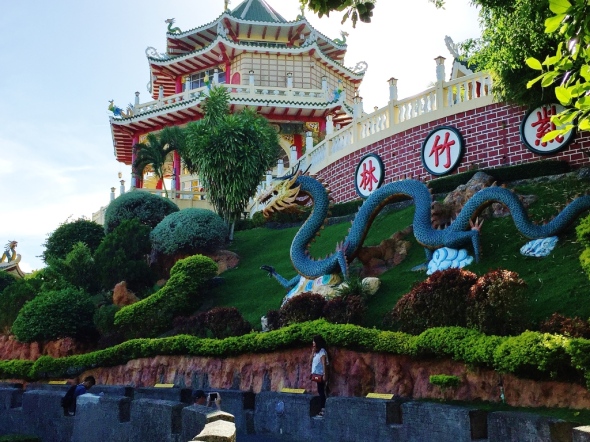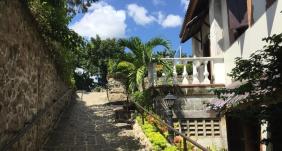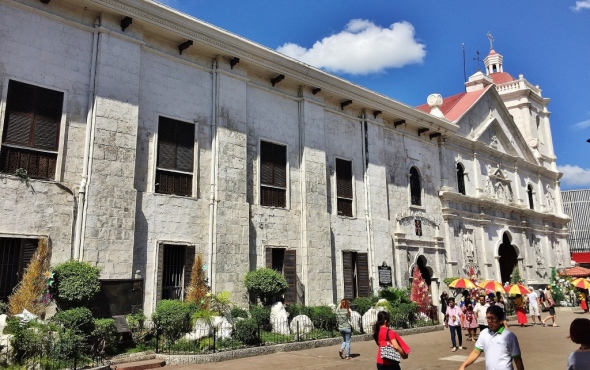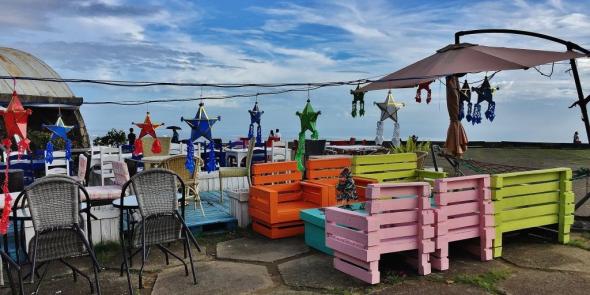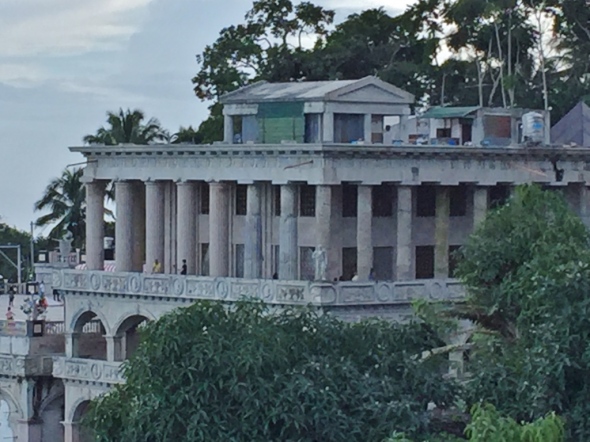
A prized possession : antique backpack bought 30 years ago. Must now be 50+ years old.
Sagada is a dream destination for backpackers. I dreamed this dream in the 80s when Sagada was just a small town in a mountain forest. To this day, I keep as a prized possession a local backpack that was already very very old when I bought it nearly 30 years ago. In one of my travels to Australia, a European backpacker tried to charm me and offered me her hi-tech backpack plus cash in exchange for mine. No way.
This beautiful town is part of the Cordilleras within the Mountain Province. The nearby town of Bontoc is the provincial capital and the nearest trade center.



A most photographed Sagada landmark, the Episcopalian Church, taken in 2008

taken December 2016

inside the church
The Town Center
The commercial center of Sagada features the Tourist Information Center (where all visitor, locals and foreigners alike, are required to register, at a P350 fee, and where arrangements for guides to the caves or just tours to the different spots can be made), the market, the centrally located inns and restaurants, souvenir shops, and where travelers commuting to Sagada are dropped off.

the town center
On a recent visit (December 2016), the town was busy and the streets were crowded with visitors, the narrow streets congested by the vans and cars that one had to literally walk sideways to avoid being sideswiped by the vehicles. There were so many interesting finds on the street sides, including those selling “binatog”, suman and native Ifugao rice.


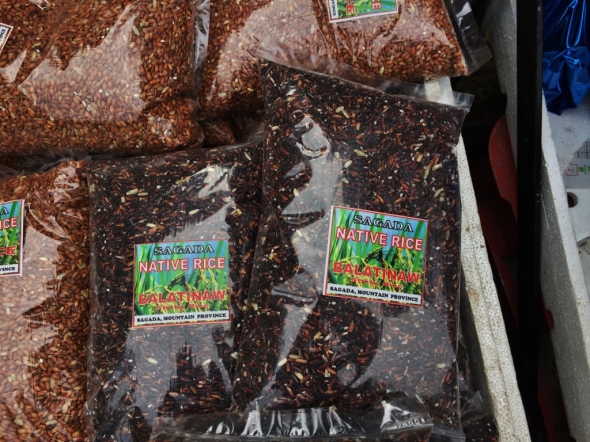
Sagada from Banaue and Bontoc
I last went to Sagada from Banaue via Bontoc. It was after a damaging typhoon that practically washed away the road. The 4×4 we were driving gave us some comfort that we will somehow get out alive from the adventure we were in – – – driving thru mud in washed out roads with deep ravines on the edges. Occasionally there were concreted portions of the road and, seeing some form of civilization, I rejoiced and laid down on my back in the middle of the road. (Update December 2016: the road is now mostly paved)
My frayed nerves were soothed by the fantastic view of nature all around us, including more terraces on the way to Sagada, just after seeing the magnificent Banaue Rice Terraces. We finally made in into Bontoc, and Sagada.
 Route to and from Baguio
Route to and from Baguio
Travel from Manila to Sagada is about 12 hours via Baguio. I admit that when I was young, I thought Sagada and Banaue were next door neighbors of Baguio. Until I realized they were very different destinations, and can not be scheduled as just a day tour – – Sagada is 140 kms away from Baguio, and is a 4-5 hour travel.
To go to Sagada, drive thru Halsema Highway and Mt. Data. We actually took this route when we returned to Manila via Baguio. When taking this route, make sure you stop at Mt Data Hotel, even just for coffee. This is the hotel with the highest elevation in the entire country.
Also a must-stop is the Highest Point view deck, the highest elevation within the entire Philippine Highway system. It is also a convenient spot for a nature break and for some drinks from the roadside stalls.
 Showbiz Sidetrip (2008)
Showbiz Sidetrip (2008)
When we last passed this route, the girls in our travel group stopped to pay homage to the tomb of teen star Marky Cielo who was interred in their backyard just the day before. In fact, the staff at Mt Data Hotel said they were never as fully booked. The GMA7 stars came to the wake and the interment.

buried in a tomb within their backyard
Accommodations:
We stayed at St Joseph Resthouse, a charming cluster of cottages in a sprawling garden, run by the Episcopalian Church. Sagada is the only town in the country that is predominantly Episcopalian. The cottage had 2 bedrooms at the ground floor, plus an attic with several beds. There are only 2 units of this “big cottage’ that rents out at P3,500 per night, accommodating 8 persons. (not updated as of December 2016, please google contact details to check rates)


The big cottage for 8 persons, with only 1 bathroom

beds on the attic
Well and good, except that there was only one toilet and bath and 8 people will have to queue. The smaller cottages opposite from ours looked charming, and had fireplaces. When the guests checked out, I asked the cleaners if I could see the room. I figured I would rather stay in this smaller cottage when I come back, and get 2 cottages when our group won’t fit in one unit.
The adjacent Cafe St Joe’s is probably the biggest restaurant in Sagada. Definitely not a 5-star establishment, but the food is tasty and the ambience is nice. The tables outside became our favorite spot for breakfast and snacks. And coffee.

I have since become a big fan of mountain coffee
We booked our St Joseph accommodations thru a lady named Mrs. Julia Abad who may be contacted at 0928 9517156, or 0918 5595934
While walking around Sagada, I checked other inns that I could stay in in next visits, if I decide not to book St Joseph. I thought that I will try George’s next time. Private rooms so cheap, with toilet and bath in the room. In fact, outside of St Joseph, rates in Sagada are the cheapest in the country. A backpacker can get accommodations for as low as P150 per person for the night. Rooms in most inns are priced within the P200-P600 range. Unless it is peak travel season (Holy Week), travelers do not need to make reservations, and instead just walk into the many inns and check out the accommodations that suit their style and their budget. The inns are just a few steps away from each other, especially on the main road where Masferre’s restaurant is located, and where the souvenir shops are found.
Accommodations Update: december 2016:
Ganduyan, one of the first inns and is centrally located, charges P300 per head, common toilet and bath.

Mother Mary
We were booked by the tour company for our December 2016 visit at Mother Mary. Quite far when compared to most inns, but I would highly recommend this inn for travelers who will visit Sagada on easier days, when visitor traffic is not expected to be terrible. So that you can take leisurely (albeit rather long) walks from the inn to the restaurants or even to the town center. Best to case the joint and decide whether to walk or to ride. But the inn is new, clean, with clean beddings and blankets. The host (and her grand kids who were assisting then (they study in Manila) were all nice and helpful. The toilets are clean. There are rooms with en suite toilets. Hot and cold water. Guests can cook on the common kitchen and use all the cooking utensils, plates, spoons and forks, etc. For a small fee. Best of all, the rent is sooooooo inexpensive. P300 per head if staying for 2 nights or more, P300 per head overnight. Quite a steal.



They also sell beautiful red “bignay” wine for only P130 per bottle. In banaue, the same stuff was being sold for P200.


Where to Eat
Other than Cafe St Joe, the popular restaurants that are worth going to include Ganduyan Cafe, where the guide who knew the owners brought us up the roofdeck. Not a fancy area, in fact plastic chairs were brought up. But it sure felt nice having a beer on a roofdeck.
Also Yoghurt House, where my friends went to while I was having a massage in my room. They said the place was busy, attesting to its popularity. (On a December 2016 visit, the place was filled to the rafters and there was only 1 flavor of yoghurt available). Yoghurt House also serves meals for lunch and dinner.
We also went to Masferre’s restaurant primarily to pay homage to this great man from Spain who adopted Sagada as his hometown. His photographs of Sagada, mounted on the walls, bring the guests to an era when Sagada was hardly visited by people from the lowlands. When only hard core adventure travelers knew about Sagada, and persisted in going in spite of the extremely difficult access to this town then. Masferre’s is now a fastfood restaurant. They officially open at 12noon, but get there as early as 11:30 as the tables may all have been taken by the early birds. Good food, freshly cooked, and you can pick exactly what you want from the food counter. A piano is available for anyone who plays.
The other popular restaurants are Lemon Pie and Salt & Pepper.
My favorite restaurant is Log Cabin. In this small town, this restaurant feels like you are in some small European country cafe. On a cold night, a fireplace provides warmth for the guests, on top of the warm reception provided by the staff. Diners need to book ahead, and even order from the menu while making reservations.

Log Cabin restaurant, my favorite
We were so glad we did. Good food, great place, low price. How can anyone go wrong? Log cabin also has a room for guests, but it was occupied when I wanted to check it out.
What to do
Or maybe what not to do. Do not expect a party place. Do not even expect bars and videokes. Sagada is a place where visitors trek, walk, and hike all day, with some red wine or cold beer after a good dinner, before going to bed early. A good night’s rest for more walks and hikes the next day.

foggy, serene, quiet. DO NOT DISTURB
On this short visit, we went to the Hanging Coffins, the Sumaguing Cave, Lake Danum, and the Echo Valley. Hire a guide from the guides’ center. All guests are, in fact, required to register at the Tourism Desk at the town hall. One guide is assigned for every 6 persons. The fees are reasonable, and definitely worth every centavo.

on the way to Sumaguing Cave
Sumaguing Cave will make you feel like Indiana Jones.You start the descent from the main road down to the mouth of the cave. And the thrill begins. The guide carries with him a hurricane lamp. We walk from spot to spot, hopping from rock to rock, holding on to crevices on the cave’s wall. I didn’t realize that the guide was actually observing each member of the group then. After wards, he organized us and made us explore the rest of the caves with the “weakest link” at the front, and the strongest at the rear. For proper pacing, and also to make sure that the weakest link is always helped by him personally.
We went inside on our shoes. Slippers are not allowed because they won’t give you grip. However, at some point, we were all told to take off our shoes, to be left in one spot, and will be collected by us on our return. It is because as we went deeper down the cave, the difficulty level also went up. The grip provided by our bare feet was much better than the sole of our shoes. And besides, we had to wade into water at some portions.
The most exciting part of the caving experience was rappelling down another section of the cave, descending from a huge boulder. Don’t worry, the guide will give you all the tips on how to successfully negotiate this part. It was exhilarating.

inside Sumaguing
 Sumaguing Cave gives explorers a feeling both eerie and peaceful. Making it back will give you a huge sense of accomplishment.
Sumaguing Cave gives explorers a feeling both eerie and peaceful. Making it back will give you a huge sense of accomplishment.
Lake Danum is postcard-pretty. It is a small lake where locals and visitors go fishing. Danum in Ilocano means water, so the lake is actually Lake Water. Eh?

lake “Water’
Echo Valley is an excellent trekking area. Some serious adventure travelers even go down deep into the valley and explore the caves, one of which has an underground river. Hanging coffins can be seen on the walls of the mountain.

Helloooo Helloooo
A local cemetery is along the way to Echo Valley. For some reasons, it is not an eerie sight. In fact, our group went around, taking photographs. Maybe the dead here are a happy lot.


Sagada Weaving
Only if really interested in weaves. Otherwise, I recommend to skip. They do not even allow photographs to be taken of the weaving process, nor of items inside the store.

Sagada Pottery: Highly Recommended

In sharp contrast with my admonition to skip Sagada Weaving, I urge visitors to check out Sagada Pottery. The potters Siegred and Tessie are so warm and welcoming. They explain the process to visitors and, for a group fee of P200, demonstrate how pottery is made. For P100, anyone can even go hand on. I loved this shop so much I ended up buying coffee cups, with prices ranging from P400 to P650 each. Same quality as Ugu Bigyan’s and cheaper.

Demonstrating how pottery is made




Backpacking next time
On this trip, I actually bought bus tickets from Manila to Bontoc, to go to Sagada. Because we decided to bring a 4×4 instead, we were unable to use the tickets. I was told I can use the tickets for another date.

My unused Year 2008 ticket, leaving Manila for Bontoc 8:30pm, P650 fare
Thus, on my next visit to Sagada, I will go by bus and have a backpack with just a few sets of clothes with me. Maybe wear the same set of clothes for 2 days or so. I think I can do this, and tell you how it feels.
Useful contact details:
Check out this site of the Sagada Genuine Guides association. Not only will you see how they are organized and are professionals, but the site will tell you more about Sagada, where to go, where to stay, and read stories about guest’s experiences share on this blog:
http://sagadagenuineguides.blogspot.com
Another site I found to be really useful and informative:
http://travel-philippines.com/locations/central-luzon/4-sagada/htm
(Sagada scene photos courtesy of a member of our Yahoo Travel group, Janna)
 An unprecedented show is going to be mounted by the Cavite Bonsai Club (CBC) at SM Dasmarinas from May 1-5, 2019.
An unprecedented show is going to be mounted by the Cavite Bonsai Club (CBC) at SM Dasmarinas from May 1-5, 2019.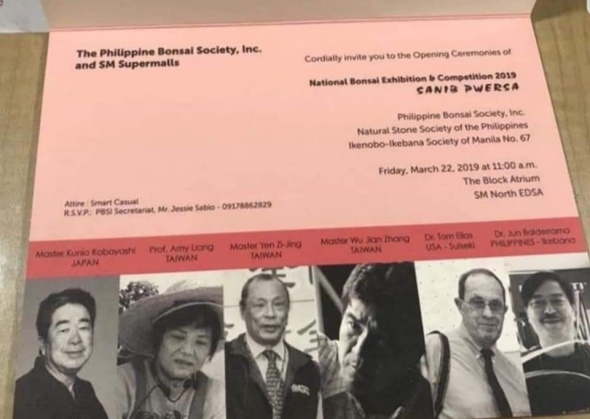

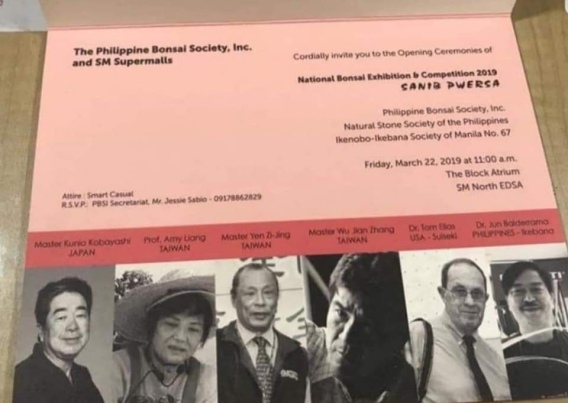
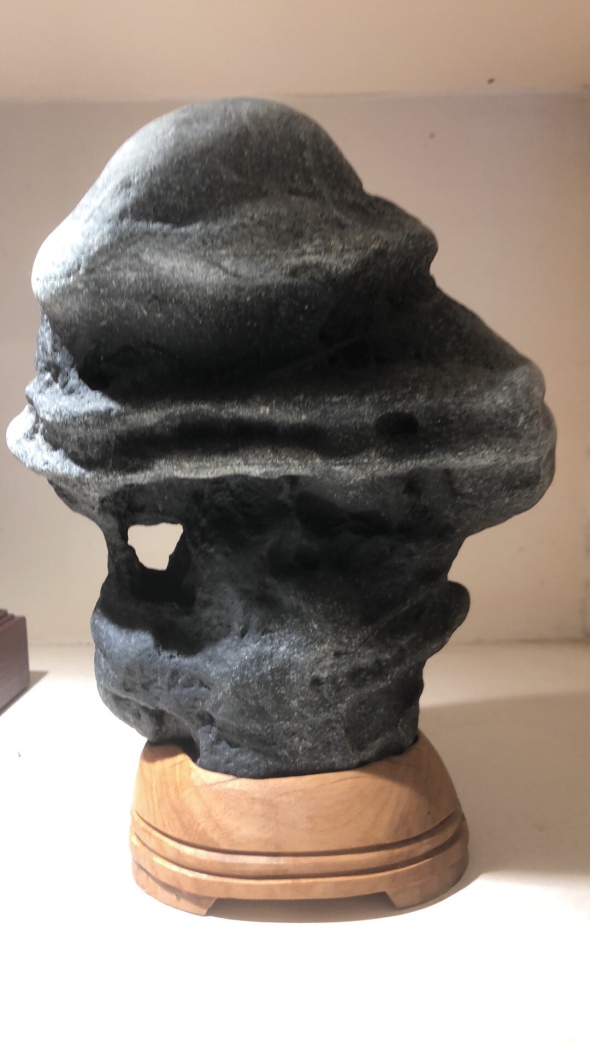
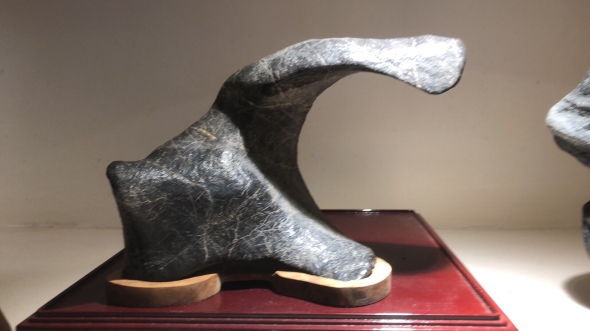
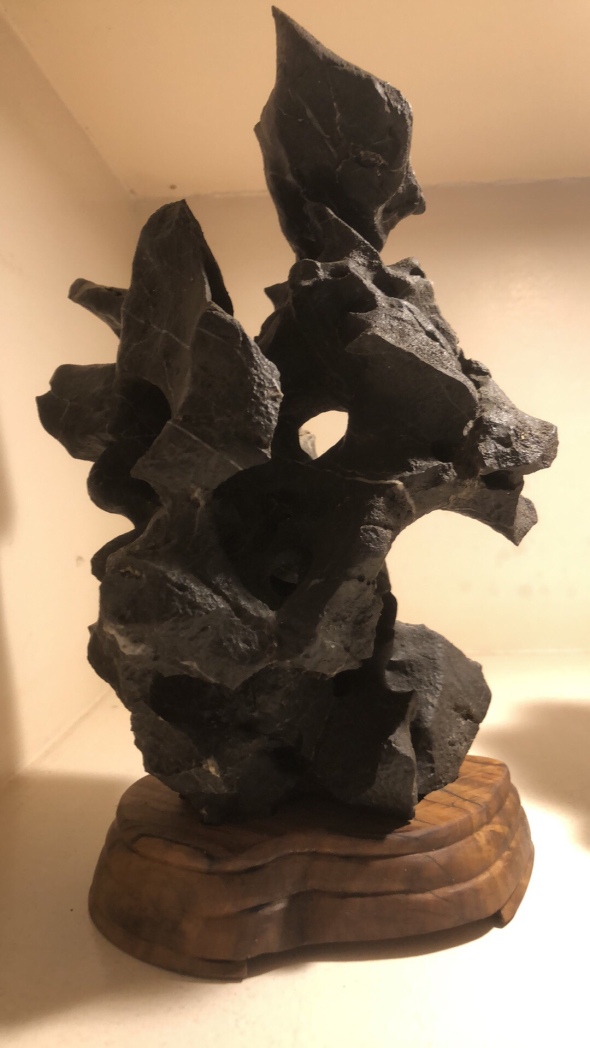 The exhibit and competition will be judged by an international panel of masters and experts from Taiwan, Japan and the USA.
The exhibit and competition will be judged by an international panel of masters and experts from Taiwan, Japan and the USA.  Bonsai Master Yen, from Taiwan is one of the judges, alongside another Taiwan master and another master from Japan, Kunio Kobayashi.
Bonsai Master Yen, from Taiwan is one of the judges, alongside another Taiwan master and another master from Japan, Kunio Kobayashi.
















































